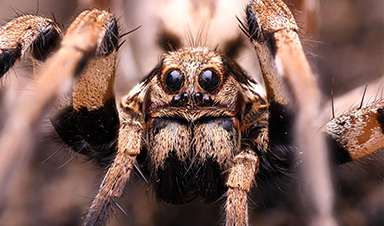Researchers at the LOEWE Centre for Translational Biodiversity Genomics (TBG) have discovered a significant diversity of enzymes in spider venom, previously overshadowed by the focus on neurotoxins.
These enzymes, found across 140 different families, could revolutionize industries by offering sustainable solutions in waste management and detergent manufacturing due to their biochemical properties. This discovery expands the potential uses of spider venom beyond traditional medical and agricultural applications, promising new research and economic opportunities.
Exploring the Complexity of Spider Venoms
With approximately 52,000 species of spiders globally, these arachnids are incredibly diverse and produce some of the most complex venoms in the animal kingdom. A single species' venom can contain more than 3,000 distinct molecules, most of which are neurotoxins designed to subdue insect prey.
However, a research team from the LOEWE Centre TBG and the Fraunhofer Institute for Molecular Biology and Applied Ecology's Bioresources branch (IME-BR) in Giessen, Germany, has uncovered a surprising discovery: spider venom is not just about neurotoxins. It also contains a wide variety of enzymes. The findings, published in npj Biodiversity from the Nature group of journals, highlight the untapped potential of these enzymes and their role in venom complexity.
Enzymatic Diversity in Spider Venom
"In the past, a few pioneering studies suggested the presence of enzymes in spider venoms, but a targeted search for them has never been carried out. We took on this task and systematically screened the raw data of all so far venom-wise analyzed spiders for enzymes. We were able to show that there are in fact more than 140 different enzyme families in their venom," explains study leader Dr. Tim Lüddecke, head of the Animal Venomics working group at the IME-BR and the Justus Liebig University in Giessen.
"This means, among others, that we have dramatically underestimated the chemical diversity of spider venoms so far, as all calculations of complexity are based on the neurotoxins alone."
Potential Applications of Spider Venom Enzymes
According to the authors, the results of the work not only enable new research approaches to better understand the evolution and function of spider venoms, but also open new perspectives for their use.
"Enzymes are key building blocks of the bioeconomy. They accelerate chemical reactions and are characterized by very low by-product formation, low energy consumption, and biodegradability. They can therefore be used to create value in a highly sustainable way. Industry is therefore constantly looking for new sources of enzymes," explains Josephine Dresler, PhD student in the working group and first author of the study.
"Some of the enzymes we have identified could be used in detergents or waste management, for example, because of their fat-splitting or protein-degrading properties. They could make a significant contribution to a sustainable transformation there," says Dresler.
Unlocking New Research and Industry Opportunities
The work of the Giessen scientists highlights the translational potential hidden in animal venoms, especially those of spiders.
"So far, the spider venom community has focused exclusively on medical or agricultural applications. Our discovery opens up the possibility of establishing a completely new field of applied research," explains Lüddecke. "But we are only at the beginning, as less than one percent of all spider species have been studied for their venoms. I am confident that we will make more exciting discoveries in the remaining 99 percent of the world's spider fauna!"
Reference: "Enlightening the toxinological dark matter of spider venom enzymes" by Josephine Dresler, Volker Herzig, Andreas Vilcinskas and Tim Lüddecke, 13 September 2024, npj Biodiversity.
DOI: 10.1038/s44185-024-00058-2
News
New skin-permeable polymer delivers insulin without needles
A breakthrough zwitterionic polymer slips through the skin’s toughest barriers, carrying insulin deep into tissue and normalizing blood sugar, offering patients a painless alternative to daily injections. A recent study published in the journal Nature examines [...]
Multifunctional Nanogels: A Breakthrough in Antibacterial Strategies
Antibiotic resistance is a growing concern - from human health to crop survival. A new study successfully uses nanogels to target and almost entirely inhibit the bacteria P. Aeruginosa. Recently published in Angewandte Chemie, the study [...]
Nanoflowers rejuvenate old and damaged human cells by replacing their mitochondria
Biomedical researchers at Texas A&M University may have discovered a way to stop or even reverse the decline of cellular energy production—a finding that could have revolutionary effects across medicine. Dr. Akhilesh K. Gaharwar [...]
The Stunning New Push to Protect the Invisible 99% of Life
Scientists worldwide have joined forces to build the first-ever roadmap for conserving Earth’s vast invisible majority—microbes. Their new IUCN Specialist Group reframes conservation by elevating microbial life to the same urgency as plants and [...]
Scientists Find a Way to Help the Brain Clear Alzheimer’s Plaques Naturally
Scientists have discovered that the brain may have a built-in way to fight Alzheimer’s. By activating a protein called Sox9, researchers were able to switch on star-shaped brain cells known as astrocytes and turn them into [...]
Vision can be rebooted in adults with amblyopia, study suggests
Temporarily anesthetizing the retina briefly reverts the activity of the visual system to that observed in early development and enables growth of responses to the amblyopic eye, new research shows. In the common vision [...]
Ultrasound-activated Nanoparticles Kill Liver Cancer and Activate Immune System
A new ultrasound-guided nanotherapy wipes out liver tumors while training the immune system to keep them from coming back. The study, published in Nano Today, introduces a biodegradable nanoparticle system that combines sonodynamic therapy and cell [...]
Magnetic nanoparticles that successfully navigate complex blood vessels may be ready for clinical trials
Every year, 12 million people worldwide suffer a stroke; many die or are permanently impaired. Currently, drugs are administered to dissolve the thrombus that blocks the blood vessel. These drugs spread throughout the entire [...]
Reviving Exhausted T Cells Sparks Powerful Cancer Tumor Elimination
Scientists have discovered how tumors secretly drain the energy from T cells—the immune system’s main cancer fighters—and how blocking that process can bring them back to life. The team found that cancer cells use [...]
Very low LDL-cholesterol correlates to fewer heart problems after stroke
Brigham and Women's Hospital's TIMI Study Group reports that in patients with prior ischemic stroke, very low achieved LDL-cholesterol correlated with fewer major adverse cardiovascular events and fewer recurrent strokes, without an apparent increase [...]
“Great Unified Microscope” Reveals Hidden Micro and Nano Worlds Inside Living Cells
University of Tokyo researchers have created a powerful new microscope that captures both forward- and back-scattered light at once, letting scientists see everything from large cell structures to tiny nanoscale particles in a single shot. Researchers [...]
Breakthrough Alzheimer’s Drug Has a Hidden Problem
Researchers in Japan found that although the Alzheimer’s drug lecanemab successfully removes amyloid plaques from the brain, it does not restore the brain’s waste-clearing system within the first few months of treatment. The study suggests that [...]
Concerning New Research Reveals Colon Cancer Is Skyrocketing in Adults Under 50
Colorectal cancer is striking younger adults at alarming rates, driven by lifestyle and genetic factors. Colorectal cancer (CRC) develops when abnormal cells grow uncontrollably in the colon or rectum, forming tumors that can eventually [...]
Scientists Discover a Natural, Non-Addictive Way To Block Pain That Could Replace Opioids
Scientists have discovered that the body can naturally dull pain through its own localized “benzodiazepine-like” peptides. A groundbreaking study led by a University of Leeds scientist has unveiled new insights into how the body manages pain, [...]
GLP-1 Drugs Like Ozempic Work, but New Research Reveals a Major Catch
Three new Cochrane reviews find evidence that GLP-1 drugs lead to clinically meaningful weight loss, though industry-funded studies raise concerns. Three new reviews from Cochrane have found that GLP-1 medications can lead to significant [...]
How a Palm-Sized Laser Could Change Medicine and Manufacturing
Researchers have developed an innovative and versatile system designed for a new generation of short-pulse lasers. Lasers that produce extremely short bursts of light are known for their remarkable precision, making them indispensable tools [...]





















